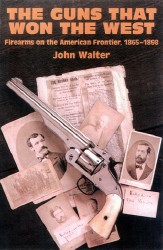CRUFFLER.COM
presents
Book
Review, March 2000:
| The
Guns that Won the West: Firearms on the American Frontier, 1848 -
1898
by John Walter Greenhill Books, 1999 Hardcover, 288 pages ISBN 1-85367-351-X |
 |
Hollywood lies.
While this may come as no revelation to many of our regular readers, the point is restricted to the common portrayal of firearms in Western movies. To watch most movies, one would suspect that the only handgun permitted west of the Mississippi was the Colt Single Action Army revolver, and the only rifle was some variant of the Winchester lever action. This is most emphatically not historically accurate, the number and type of firearms in the American frontier being as variegated as the people who populated it.
Prolific gun author John Walter thoroughly explores this fascinating topic in one of his latest works, The Guns that Won the West: Firearms on the American Frontier, 1848 - 1898. Typical of such Walter compendia as Rifles of the World, the book is like a well written travel guide which gives the the reader a good introduction to a sweeping array of places, but requires those who desire a more detailed narrative on any one site to seek additional information. Indeed, while Walter covers just about every firearm of note in the fifty year period addressed by the book, one will have to go elsewhere for detailed data on the guns.
Characteristically, Walter weaves the technical details about the guns (which, even for this most hardcore firearms aficionado can get a tad dry) into a far richer fabric that encompasses the production techniques of the times, the contemporary economic reality, technical advances, and the cumulative effect of the ready availability of inexpensive Civil War surplus weapons on the West's social and political climate. Additionally, Walter introduces his readers to the wide array of colorful frontier characters that includes settlers, railroad men, ranchers, Indians, prospectors, outlaws, and soldiers. Also discussed at length is the manner in which use influenced design, and in return, how design influenced use. The following excerpt is typical of Walter's meshing of history and technology. Here, he discusses the Henry repeating rifle in light of the attitude of the US Army's antediluvian Chief of Ordnance:
"Series made Henry Rifles were available from the summer of 1862, enabling many to be sold to state militia and volunteer units. Brigadier General James 'Old Fogey' Ripley, the incumbent Chief of Ordnance, had a particularly harsh view of the new repeater. As early as the autumn of 1861, after reviewing a prototype Henry rifle, Ripley had 'failed to discover any important advantage . . . over several other [single-shot] breech loaders, as the rapidity of fire with these latter is sufficiently good for useful purposes without the objection to increased weight from the charges in the arm itself, while the multiplication of arms and ammunition. . . is decidedly objectionable, and should, in my opinion, be stopped by the refusal to introduce any more.'Perhaps the only negative comment that can be said about this book is that it lacks the comprehensive and detailed illustration that one comes to expect from Walter's books. Compared to the equally ambitious work Central Powers' Small Arms of World War One (see CRUFFLER.COM Review, July 1999), The Guns that Won the West is practically devoid of illustration. While there is a photographic plate section of sixteen pages, and the odd line drawing scattered through the text, these are not keyed to the text and offer little pedagogical value. This is additionally discouraging to both the neophyte firearms aficionado and the historian to whom firearms are parenthetical, as the sheer number and variety of firearms covered in the book can be overwhelming without any graphical reinforcement to the text. Also, the period covered by the book was one of great foment and inventiveness in the firearms industry, and many of the subject firearms were of novel or unique construction or design. As a result, drawings or photographs would have been invaluable in understanding how they functioned.
This drawback should not dissuade
anyone from purchasing this book though. It is a must have for the
student of not only firearms, but of American history as well. It
is one of the few, if not the only, comprehensive volume on this subject
matter and goes a long way towards clarifying and demystifying what was
a most tumultuous time not only for the American firearms industry, but
for the country as a whole.
The
Guns that Won the West is available
from Amazon.com. Click on the image to order:
